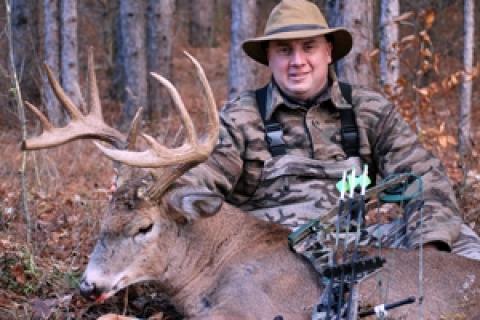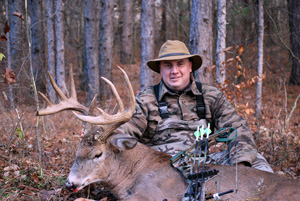
The key to growing, and for that matter, hunting mature bucks, can be boiled down to two words: "low" and "impact." Alone they mean little; together they are the Rosetta Stone of big buck hunting. If you take nothing else away from reading this article, memorize this phrase: low impact, and never forget it. These two simple words drive virtually everything my son and I do as landowner/hunters, as deer managers, and as professional wildlife consultants. And they need to drive your hunting strategy as well.
While most hunter/landowners take readily to managing habitat and deer numbers, they often have trouble embracing the paradigm shift and discipline required to practice "low impact" deer hunting. Sure, most hunters can learn to keep ATV use to a minimum, and have long since stopped slamming truck doors, but some just don't seem to be able to give up certain ritualized behaviors like pre-season scouting, hanging last minute stands, hunting the same stand over and over, and staying out of "off limits" deer sanctuaries. The concepts behind "low impact" hunting are relatively simple to grasp, but the discipline required to implement them doesn't come easily.
 Learn Your Hunting Property
Learn Your Hunting Property
If you are going to consistently take mature bucks from a property you have to learn the property you are hunting, and how the deer use it. You can't effectively hunt big bucks if you don't know where they hang, what they eat, and how they travel. You also can't successfully hunt big bucks if you can't set up on them with a minimum of disturbance. Exploring at any time is disruptive and undesirable but without this knowledge you are basically shooting in the dark and hunting by trial and error. Topo maps and aerial photos are a must if you are to identify bedding areas, feeding locations, and travel routes. You need to understand everything you can about the property you are hunting.
A Time to Learn, a Time to Hunt
The best time to learn how your property "works" is early winter, a few weeks after hunting season ends. The worst time to learn it is a few weeks before hunting season (unless you are not planning on hunting there that season). Post-season deer are still in their hunting season mode (as far as deer movement and patterns go), and you just may find some tracking snow to help you out. If you wait until a few weeks after the season to do your work, the deer will be settled sufficiently so that you can move about without starting an all-out deer stampede. Deer sign is generally easy to find this time of year as the ground is soft, the trees are rubbed, scrapes are in evidence, and feeding and bedding areas are readily identified. Best of all, the sign laid down recently was created under hunting conditions. Take a pencil and begin to pencil in deer travel routes on a topo map. Same goes for feeding areas and bedding locations.
Walk 'Em Back
Post-season is also a super time to learn how that old buck you hunted last season beat you at your own (or his own) game. We call this "walking 'em back" which basically refers to slipping into your hunting areas and walking the tracks backwards. Take a close look at the trails around food plots or your stand locations. How did the majority of the deer approach the area? Where did they come from? Where did they scent you from? Have they figured you out? How can you change the set-up to beat them next year? (Remember, deer are scent driven). Now move 50-150 yards down wind to the prevailing winds and look for more evidence of deer skirting your hunting set-up. It won't be as pronounced as a primary trail into a feeding area, but more than likely, the sign will have been made by a mature deer. Deer have the ability to scent-check a food plot or stand locations from a few hundred yards away and you can bet a mature old buck will do it every opportunity he gets.
Don't be afraid to take your pocket camera along and take a bunch of photos. It costs nothing, and they can be real handy when going over your maps a few months later. The idea is to get enough detail on the map to jog your memory 5 or 6 months later when you dig out the old map to help you set a few stands for the fall. And remember, scouting is more than a leisurely walk in the woods. You are on a mission to find things out and you should view it accordingly. The quicker you learn the property, the quicker you can stay out of it! That's right, stay out of it.
Now Stay Out of the Woods
Pre-season "scouting" is ritualistically observed by hunters and a wonderful tradition, but in most cases, all it does is screw up your deer hunting property. You get together with your hunting buddies, pound down some beer and brats, and head for the woods. You check the same old crossings for tracks, the same old overhanging branches for scrapes, and the same old rubbing trees for "buck sign." You have learned absolutely nothing you didn't already know, and have alerted every deer in the area that the hunt is on. You may as well have traipsed through the woods with a megaphone blaring, "Hunt on-hunt on!"
Hunters call it "scouting" to legitimize their fun and attach some importance to it. What we should call it is "warning" or "alerting" maybe even "harassing." "Come on guys, let's head to the woods and harass some deer." Sounds a little strange, doesn't it, especially a few days before the opener when most guys do it?
Once you figure out your property, GET OUT AND STAY OUT! This is one of the toughest parts of hunting low impact. For some reason, hunters just can't stay out of the woods-even hunters who know better. They hang stands and do a little trail trimming just to be sure every deer in the area knows bow season is upon them. Some hunters hang stands in the middle of the day to avoid spooking deer. Forgetaboutit! Deer know when you have been in the woods! If you are going to hang a stand in the middle of deer season, you had better have a good reason for doing it, and had better hunt it right away because every buck in the area will know you've been there within 36 hours. The old ones will know what it means; the young ones will just keep on keeping on and leave you convinced you can get away with all that disruption.
Big bucks don't know the difference between scouting and hunting. Show up in a slammer buck's back yard, and you'll put him on red alert. He'll go nocturnal in a day or two. If he doesn't leave the area immediately, he'll do so as soon as he senses a little hunting pressure. If you are going to kill bucks, then you have to go low impact.
Successful hunters learn their hunting areas, and then stay out of them as much as possible. They hang stands and trim branches during turkey season and leave it be. They see no reason to "scout" each and every season. If they were there once, they will be there again. Big bucks tend to use the same areas year after year. It takes self discipline and a commitment to stay out of the woods when the temps start to drop and the leaves start to turn, but stay out you must.
- 5761 views

